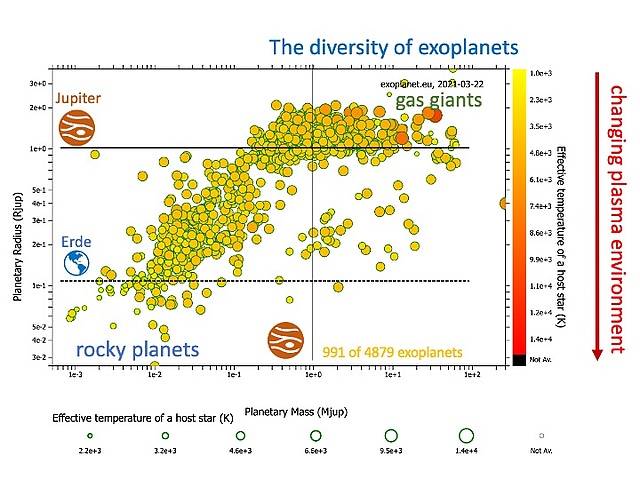The physics & chemistry of extrasolar atmospheres
The discovery of planets outside of the Solar System (exoplanets) has revolutionized our understanding of planet formation and the evolution of planetary systems. It revolutionizes the understanding of humankind and its place in the universe. Recent observations on the ground and in space do now enable the characterization of the atmospheres of exoplanets which came in a large diversity. The understanding of cloud formation is one of the major keys to unravel the diversity of exoplanet atmospheres because they block our view onto the planet of interest. In our solar system, Jupiter, Saturn and Uranus are covered in clouds and it is difficult to impossible to discern what lies beneath them.

Our research group is particularly interested in understanding the weather and climate on extrasolar planets that orbit different host stars (see figure above), how and which clouds form on these worlds, how they affect the local chemical composition and the atmosphere structures. We further investigate how ionisation processes (thermal, high-energy radiation, cosmic rays) affect the local chemistry as well as the cloud particles. We use modells as virtual laboratories that allow us to access unexplored parameters spaces to study the weather and the climate processes on yet unexplored worlds. The fundamental physics and chemistry modelling conducted in our research group is the backbone to enable the data interpretation from space missions like the James Webb Space Telescope (JWST), and in the future PLATO and ARIEL.
Overarching Science Questions that drive our research are:
- How diverse are exoplanets?
- Is our own Solar System special or typical?
- How can we reliably infer exoplanet properties from observations?
- How can we infer the history of exoplanets despite the complexity of the system?
- Could life evolve outside of the Solar System?
Our group develops virtual laboratories, i.e. computer codes, that enable us to combine complex physical processes in order to explore their interplay and to study parameter ranges (like temperature, pressure, radiation field, chemical regimes) that are not accessible by observations nore by laboratory experiments yet. We have joint forces with researchers working on planet-forming disks (including theIWF research group Planet Forming Disks & Astrochemistry) in order to hand on our knowledge to the next generation of researchers within the CHAMELEON network. Our work is enabling the scientific exploration of observational data (Min et al. 2020, Chubb et al. 2020) in preparation of space missions like JWST, PLATO and ARIEL.
Specific topics that our group works at are:
- Kinetic cloud formation in diverse atmospheric environments
- Formation of cloud condensation nuclei in planets other than Earth
- Mapping the global cloud distribution of extrasolar planets based on 3D GCMs
- Ionisation processes and the emergence of ionospheres on extrasolar planets
- Chemical composition of exoplanet atmospheres and their possible link to planet formation
For more information, please also see here: Exoplanet Weather & Climate @ IWF
All our publications can be found on ADS which is linked to arXiv.
James Webb Superstar: Gastkommentar in der Wiener Zeitung von Dr Ludmila Caron: "Warum das neue Weltraumteleskop, das uns detailreiche Bilder aus den Tiefen des Alls liefert, so wichtig ist."